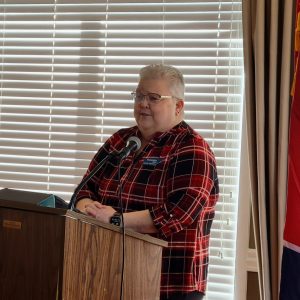Women of the Revolutionary War

Melissa Edwards
By ZOË WATKINS
zwatkins@bedfordcountypost.com
The March meeting of the Shelby Chapter of the Daughters of the American Revolution featured Melissa Edwards, Chapter Vice Regent, who spoke on how women played a part in the bloody war that severed the country’s tie with Great Britain.
Over the course of researching the topic, Edwards concluded women played many valuable roles in the war.
“During the first 150 years of colonial life in America, women shared in the hardships of building a new life in a place where society was anything but stable,” Edwards began. “Women were skilled in many ways due to their colonial experiences, but this does not mean that they were considered the equals of men.”
Still, war was unavoidable. It took place in their gardens, cow pastures, backyards, and in the streets.
“War was virtually in every place women worked and lived,” said Edwards.
As a response, women were “energized,” and stepped out of their societal roles.
Some would have stayed behind and kept care of the farms while the men fought on the frontlines. While tending to the homesteads, women often baked loaves of bread or knitted garments for soldiers.
Edwards retold one account where a Ruth Draper from Connecticut baked bread for several days and encouraged her neighbors to do the same. She ended up having enough bread, cheese, and cider to feed hundreds of troops who arrived at her farm. She also turned in all her pewter dishes so the army could make bullets—bullets used to fire at the British.
Edwards recounted another story in which, “The brave wife of Major General Philip Schuyler burned the wheat fields of her own estate near Saratoga so that the approaching British, who were running low on food, could not use the grain.”
Some women were also designated “camp-followers,” where they literally followed the camp of soldiers to help cook, mend and wash clothes, and do any other helpful tasks.
“Although General [George] Washington had difficulty deciding if it was a boon for these people to be there or just another drain on their already scarce supply. But it turned out they were very useful,” said Edwards.
She said women often followed the army for their own protection, “out of necessity,” and to keep families together.
“Camp-follower Sarah Osborne Benjamin, for example, recorded in her pension application that she joined the Army because her new husband asked her to do so,” Edwards retold. “While marching through Philadelphia in 1781, a group of Quaker women asked her stay with them, but her husband said, no, he couldn’t bear the thought of her being left behind.”
Many people may remember from the story of Molly Pitcher. Though there is no record of an actual Molly Pitcher, according to Edwards, her story is likely based off of several real, camp-follower women.
But there’s one woman, Mary Ludwig Hays from Carlisle, Penn., who is the primary inspiration.
“Molly” was also a nickname for Mary, and as the story goes, as men lay in the field at the Battle Of Monmouth, burning with heat-exhaustion from the hot sun, they would beg, “Molly, water!” or “Molly, pitcher!”
“One story has been passed down by a witness who described: a cannon shot from the enemy passed between her legs without any other damage than carrying away all the lower part of her petticoat. Looking at it with apparent unconcern, she observed that it was lucky it did not pass a little higher for in that case it might’ve carried away something else,” said Edwards.
Margaret Corbin, a.k.a. “Captain Molly,” took place of her husband who had died at his cannon at Fort Washington. She was wounded by grape-shot and was the first women to receive a pension, which was passed by the Continental Congress in 1779.
However, some women hid their sex and disguised themselves as men to join a regiment.
The consequences were dire if they were found out, such as imprisonment, public humiliation, or a fine.
But some women managed to elude authority. One of the most famous disguise stories is that of Deborah Samson from Plymouth, Mass.
In this case when she was first found out, she was sent home and told to “act like a proper woman,” according to Edwards.
But in October of 1782, at the age of 22, she tried again, this time enlisting as a Robert Shurtleff and serving in a company from Midway, Mass.
She received two wounds: one was a sword cut to her head and the other was a shot in the thigh.
“To avoid being discovered, she hid in the woods and treated herself till she was able to rejoin the troops,” Edwards said.
However, when she came down with “brain fever,” a doctor from Philadelphia discovered her secret. Instead of turning her in, he took her under his wing and took care of her at his home.
She eventually received a dishonorable discharge in October of 1783 and she returned to Massachusetts where she married and had three children. Beginning in 1802, she completed a year-long lecture tour about her experiences as a soldier, even sometimes dressing in full military regalia to do so, according to the National Women’s History Museum.
Samson died in 1827 at the age of 66.
Other women also served as messengers and in espionage.
“Stories tend to highlight the male agents but women were frequently overlooked and had more means of gathering and delivering information in an unobtrusive fashion than they did,” said Edwards.
Spying was an act of treason and the penalty was death. So they got creative. Women would sew messages into garments or hide notes in balls of yarn.
Whatever the means were, these women sacrificed more than wheat, pewter, balls of yarn and gowns.
Edwards finished, “While their stories all differ, every woman stood up for what she believed. The desire to aid her new country’s independence drove each one to risk her life for the patriots’ cause. Their roles were often unheralded and undiscovered, but these women’s contributions were invaluable.
“They were true American Patriots.”





![For-Tips-and-Ideas-Phone-300x250-Bedford-County-Post[1]](https://www.bedfordcountypost.com/wp-content/uploads/2023/09/For-Tips-and-Ideas-Phone-300x250-Bedford-County-Post1-300x250.jpg)
![Subscribe-Now-300x250-Bedford-County-Post[1]](https://www.bedfordcountypost.com/wp-content/uploads/2023/09/Subscribe-Now-300x250-Bedford-County-Post1-300x250.jpg)

